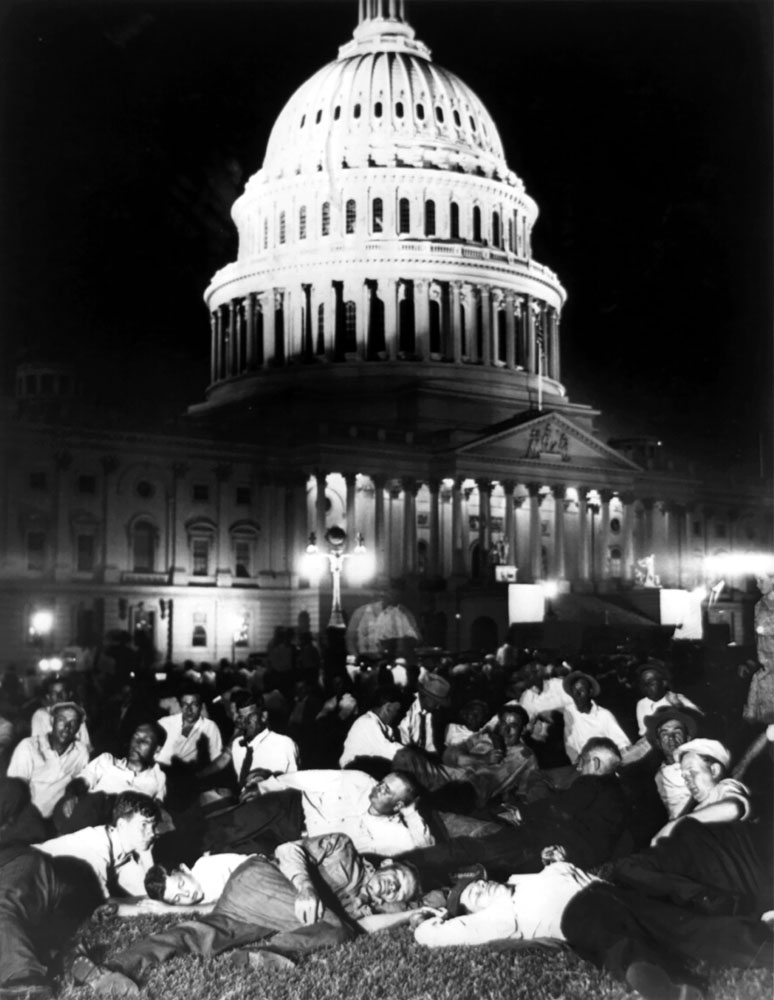 |
The Positive Power of DissentBy Paul NicholsThe front cover feature article of the May/June 2006 Disabled American Veteran (DAV) magazine began with the following quote: "In October 1929 the stock market crashed, 40 percent of the paper values of common stock crashed with it, and the nation was soon plunged into its greatest economic depression." Banks failed, businesses shuttered, farmers' crop prices fell, homes were foreclosed on, unemployment spread, and suicide rates mounted. The American people grew destitute as the economy plummeted. The Great Depression wasn't the main focus of the DAV piece. However, it provided the impetus for bringing to light The March of the Bonus Army, a moving 30-minute PBS documentary chronicling thousands of World War I veterans who demonstrated in Washington, DC. The film, partially funded by the DAV, first aired on TV around Memorial Day 2006. It contains archival photographs and newsreel footage, music of the period, and powerful interviews. The documentary is still available, and I urge anyone interested in this relatively unrevealed saga in our country's history to check it out. Like so many US citizens, veterans and their families were impoverished. Desperate times acted as the catalyst for World War I veterans, including thousands who had been drafted, to actively seek the compensation Congress had authorized in 1924 for economic losses incurred while they were in the military. The bill Congress approved stipulated that such bonuses would not be redeemed until 1945. "Bonus" was the derogatory term used by opponents of the legislation. This ridiculous redemption limitation meant that many veterans would be dead by that time. It was referred to by vets as the "Tombstone Bonus." In the spring of 1932, a few hundred veterans marched to Washington hoping to initiate the timely issuance of the promised bonuses. This group was known as the Bonus Expeditionary Force, a takeoff from the formation of troops sent to fight in France designated as the American Expeditionary Force. By that summer nearly 45,000 men women and children had descended on Washington, setting up camps near the US Capitol Building. Some politicians viewed the growing mass as an unruly mob, an invasion that would incite social disorder — maybe even a revolutionary threat. Republican President Herbert Hoover argued that a communist takeover was in play. He ordered Army Chief of Staff General Douglas MacArthur to raze the massive encampment (known as "Hooverville") and disperse the vets and their families. To no avail, Major Dwight Eisenhower advised MacArthur not to attack the vets. In late July 1932, Major George Patton led the effort, sending hundreds of infantrymen, some on horseback, armed with bayoneted rifles, machineguns and gas grenades. Six tanks entered the fray to support the cavalry. A violent assault ensued as Patton's troops and the police attacked the peaceful inhabitants' camp, while Hoover watched from a White House window. Military forces threw gas grenades, set fires and opened fire with rifles. Over 100 demonstrators were injured, several were jailed, two were killed, and their makeshift shelters were destroyed during the intervention. Public sentiment was highly supportive toward the tent city demonstrators. The Veterans of Foreign Wars organization urged early federal payment of the money owed to the veterans. Franklin D. Roosevelt won the 1932 presidential election by a landslide. FDR helped thousands of war veterans find jobs through the popular Civilian Conservation Corps work program enacted early in 1933 under his New Deal initiatives. During 1936, four million World War I veterans received their long-awaited bonuses. This led to the eventual enactment of the Servicemen's Readjustment Act of 1944, known as the GI Bill. This story brings to mind the myriad demonstrations during my lifetime, many of which have brought about positive change. Included are those connected to the Civil Rights Movement of the 1950s and 1960s, opposition to President Reagan's Nicaraguan Contra war in the 1980s, the massive anti-war marches of the 1960s to early 1970s during the Johnson and Nixon administrations, and both Bush wars against Iraq to name a few. Key to the necessity to protest has been fear, racism, arrogance, and lies promoted by those in seats of power. Peaceful expression of opposition has never been more vital than since the 2016 election of President Tweet. All of the reasons I've mentioned to reject the current president's actions stare us starkly in the face. Hatred, insensitivity, selfishness, and others can be added. Two recent monumental demonstrations have taken place in Washington, DC, and across our nation: the 2017 Women's March and this year's March for Our Lives. Smaller ones erupt regularly due to valid concerns. The president's alarmist pronouncements against those who question or disagree with him are subjected to his wrath. Similar to Hoover, expressions of "mob" and "invasion" are cast on a daily basis. The commander-in-tweet hurls the words "socialists," "fake news" and "witch hunt" as his followers swoon with approval. Protest was how the United States began and, with elections, are essential agents for change. Paul Nichols is a Vietnam veteran and life member of the Disabled American Veteran (DAV).
|


